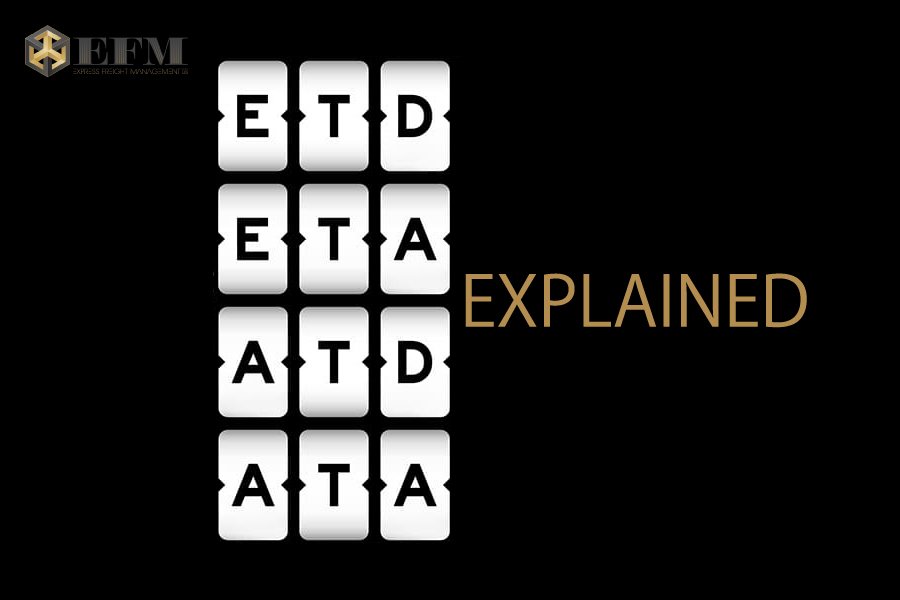ATD, ATA, ETD, ETA Meaning Explained

Companies are shifting their supply chains out of China and Southeast Asia is cashing in. This “China Plus One” wave is, however, easier said than done. It is not just switching suppliers, after all. Businesses have to build entire new logistics networks in less familiar corridors. The supporting infrastructure may not be as robust. Language barriers are higher, as businesses deal with a multitude of cultures across the region.
The need to “go back to basics” cannot be more apparent under this new backdrop. For companies navigating these expanding U.S.-ASEAN trade routes, a mastery of fundamental logistics metrics—ETD, ETA, ATD, and ATA—is essential for building resilient and reliable supply chains.
ETD
ETD, or Estimated Time of Departure, is the projected time a shipment will leave its point of origin. Take for example, a shipment of textiles leaving the Port of Los Angeles for Singapore. Logisticians will use the ETD provided by the freight company to plan the next steps of the process. This includes warehousing, trucking, last-mile delivery, etc.
ETA
ETA, or Estimated Time of Arrival, is the projected time a shipment will reach its destination. Take sea freight for example, shipping from Thailand to the United States typically takes around 5 to 8 weeks. The ETA would then be calculated based on that transit time from the ETD.
ATD
ATD, or Actual Time of Departure, records the exact time a shipment departs its origin. Unlike the estimated ETD, the ATD reflects real-world conditions, which may include delays due to port congestion, customs clearance issues, or weather. For example, a shipment with an ETD of 9:00 AM from a Long Beach warehouse to Malaysia might face a delay due to loading issues, resulting in an ATD of 2:00 PM. Reliable freight forwarders communicate ATD updates promptly to adjust downstream logistics plans.
ATA
ATA stands for Actual Time of Arrival, marking the moment a shipment reaches its destination and is unloaded. This also marks the end of that phase of transportation.
Real World Application
Here’s how these terms apply to a U.S.-ASEAN trade scenario using ocean freight:
- Planning Phase (ETD & ETA): A Texas-based manufacturer books a shipment of machinery parts to Ho Chi Minh City, Vietnam. The freight company confirms an ETD of October 1 and an ETA of November 22 for arrival at the Port of Ho Chi Minh City. The manufacturer uses these dates to prepare customs paperwork and notify Vietnamese clients.
- Actual Departure (ATD): Backlog owing to a three-day port strike delayed departure by 5 days. ATD is therefore recorded as October 6.
- Dynamic Adjustments: The freight company updates the ETA to November 27 based on the new ATD. It then updates the Vietnamese client, who adjusts pickup and distribution plans accordingly.
- Arrival at Destination (ATA): The shipment arrives in Ho Chi Minh City on November 27. However, it only completes unloading and customs clearance one day later, setting the ATA as November 28.
Summary Of Terms
| Abbreviation | Full Name | Description |
| ETD | Estimated Time of Departure | The projected time a shipment leaves its origin. |
| ETA | Estimated Time of Arrival | The projected time a shipment reaches its destination. |
| ATD | Actual Time of Departure | The actual time a shipment departs its origin. |
| ATA | Actual Time of Arrival | The actual time a shipment arrives and is unloaded. |
Why It Matters
In the dynamic U.S.-ASEAN trade corridor, where supply chains are actively being re-drawn, precision is paramount. Mixing key terms like ETD, ETA, ATD, ATA up would likely cause disastrous knock-on effects down the supply chain. As such, it is crucial to understand them for better tracking and liaising purposes.
For businesses seeking reliable logistics solutions, partnering with an experienced freight forwarder can streamline U.S.-ASEAN trade. Comprehensive services, including ocean, air, and ground transport, as well as customs clearance and warehousing, ensure your supply chain runs smoothly. Contact a trusted logistics provider to explore tailored solutions for your U.S.-ASEAN operations.
For nearly two decades, Express Freight Management has been the trusted partner for businesses shipping between the United States and Southeast Asia. We handle the technological complexity for you, managing everything from carrier selection and customs clearance to warehousing. Discover a streamlined approach to logistics with Express Freight Management for your shipping needs between the United States and Brunei, Cambodia, Indonesia, Laos, Malaysia, Myanmar, Philippines, Singapore, Thailand, and Vietnam today!
